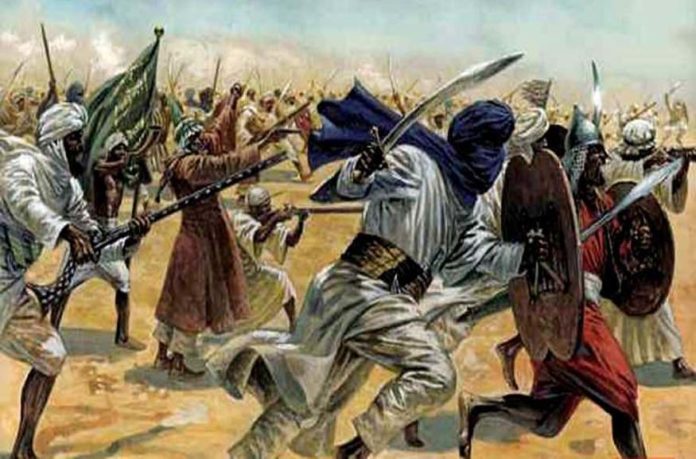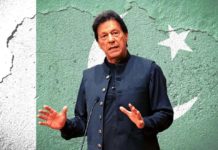Disclaimer: The Eqbal Ahmad Centre for Public Education (EACPE) encourages critical and independent thinking and believes in a free expression of one’s opinion. However, the views expressed in contributed articles are solely those of their respective authors and do not necessarily reflect the position or policy of the EACPE.
The textbooks that are taught to Pakistani children recount exploits of numerous past Muslim heroes in them. Standing tall amongst these heroes is one Arab by the name of Muhammad bin Qasim, born on 31 December 695 in the city of Taif in modern day Saudi Arabia.
Following are just some of the tokens of Pakistanis’ veneration for their hero.
He is sometimes called ‘the first Pakistani’. Port Qasim, Pakistan’s second major port is named in his honour. PNS Qasim is the name of a Pakistani Naval ship. Qasim is a fairly common first name for Pakistani male children. The day of Yom-e-Babul Islam is observed each year in Pakistan in memory of Muhammad bin Qasim.
Now let us see what we are told about this hero and what we are not.
We are told that Muhammad bin Qasim was an Umayyad general who conquered the Sindh and Punjab regions, now a part of Pakistan, along the Indus River. That at the tender age of just seventeen, he was sent by Caliph Al-Walid-I to lead an army towards South Asia to release Muslim women and children who were kidnapped by the Hindu Raja of the time. That it was due to his conquest of Sindh and Punjab that the era of Islamic rule in South Asia was first launched in real earnest. This much we are told. Pakistani children are supposed to memorize and be examined in.
What we are not told is that the kidnapping event of women and children, though a historical happening by itself, may have been only a part of the legend. That the Umayyad interest in the region may have stemmed more from their desire to control the trade route down the Indus River valley to the seaports of Sindh, an important link in the ancient Silk Road, than anything else. That on certain earlier occasions too, they had unsuccessfully sought to gain control of the route, via the Khyber Pass, from the Turki-Shahis of Gandhara. That by taking Sindh, Gandhara’s southern neighbour, they were ultimately able to open a second front against the Gandhara.
We are also not told some of the other possible reasons for this campaign. That the primary reason cited in the Chach Nama, that authentic document that recounts the history of Sindh in great details, for the expedition by the governor of Basra, Al-Hajjaj ibn Yusuf, against Raja Dahir was a pirate raid off the coast of Debal resulting in gifts to the caliph from the king of Serendib (today’s Sri Lanka) being stolen. That the Meds, a Sindhi tribe also known as Bawarij, had targeted Sassanid shipping in the past too. That they sniped the trade routes frequently from the mouth of the Tigris to the Sri Lankan coast, from their bases at Kutch, Debal and Kathiawar.
We are also not told that possibly the real reason of the campaign may have been purely economic in which the kidnapping of women and children was but one fateful act of these semi-nomadic tribes whose activities disturbed much of the Empire’s shipping trade in the Western Indian Ocean. That the kidnapping incident may only have provided a ‘just reason’ to the rising power of the Umayyad Caliphate to gain a foothold in the Makran, Baluchistan and Sindh regions–an area the Empire builders had been eyeing for a rather long time by then. That one other possible reason for the campaign could be the policy of the local tribes of providing refuge to Sassanid and Arab rebels who fled the Arab advance and the accompanied Umayyad persecution in a quest to consolidate their rule. This we are not told.
We are told that he treated most kindly his new subjects when he became their governor. What we are not told is that where resistance was strong, long-drawn-out and rigorous, Muhammad bin Qasim’s response was rather ruthless. By credible accounts, he inflicted 6,000 deaths at Rawar, between 6,000 and 26,000 at Brahmanabad, 4,000 at Iskalandah and 6,000 at Multan. And that he built many mosques upon the sites of razed Hindu temples.
But above all what we are not told is the manner of this hero’s death and the events leading up to the occasion.
We are told that his nemesis Raja Dahir was a cruel and unjust ruler and was involved in piracy. That he was the one that kidnapped and tortured the women and children and refused to recant. That he was an immoral man that married his own sister.
What we are not told is that Raja Dahir is also admired by many present day Sindhi Sunni and Shia Muslims. That he had given shelter in Sindh to a well-known follower of Imam Hussian, Muhammad Bin Allafi–a man much sought by the Umayyad in their deadly hunt for eliminating the last of the Ahl-e-Bait (Prophet Muhammad’s immediate family). That, according to some other sources, Dahir had even offered asylum to Hussain ibn Ali, the grandson of Prophet Mohammed, who was being persecuted at home. That as a result of this offer, Hussain was on his way to Sindh when he was seized at Karbala in Iraq and killed most viciously. That according to G.M. Syed, the grand old man of Sindh, “the Sindhis weep for Hussain ibn Ali and they weep for Raja Dahir Sen.” This we are not told.
But above all what we are not told is the manner of this hero’s death and the events leading up to the occasion.
Chach Nama tells of an intriguing yet widely believed tale of Muhammad bin Qasim’s death. According to this account, when Raja Dahir was killed in the battlefield, his daughters were captured as war booty in the Islamic tradition. The Governor, Muhammad bin Qasim, then sent them as ‘presents’ to the Caliph of the time Khalifa Sulayman ibn Abd al-Malik, to become a part of his vast harem. According to the narration, the women tricked the Khalifa into believing that Muhammad bin Qasim had violated them before sending them on. Reportedly, the Khalifa got so incensed for having been sent ‘tainted’ gifts that he ordered Muhammad bin Qasim returned to Syria wrapped in oxen hides, his exploits not withstanding. The journey is said to have resulted in his death from suffocation.
The aforementioned version attributes the women’s motive for the ploy to exacting vengeance for their father’s death. It also states that upon discovering the trick after the death of Muhammad bin Qasim, the Khalifa deeply repented his action and ordered the sisters buried alive in a wall as a punishment.
The Persian historian Baladhuri, however, states that the Khalifa Abd al-Malik was a political enemy of Umayyad governor Al-Hajaaj ibn Yusuf, Muhammad bin Qasim’s paternal uncle. He persecuted all those who were considered close to Hajaaj after his death. Muhammad bin Qasim was therefore recalled in the midst of a campaign of capturing more territory up north. An honourable man, he reported to his Caliph despite his loyal friends dissuading him from it. Upon arrival, he was promptly imprisoned in Mosul, Iraq. Intensely cruel torture on him started immediately afterwards. So severe was this torture that on one hot July afternoon Muhammad bin Qasim breathed his last during the most extreme of these sessions.
Whichever account is true, we are told none of these.
Two facts, however, remain undisputed.
First, he was 22 years old when his own Caliph ordered him killed. Second, none have read the tombstone marking his grave for none know where he lies.
No tombstone for the hero?
About the Author:
 Anwaar Hussain is an ex F-16 fighter pilot from Pakistan Air Force. A Masters in Defense and Strategic Studies from Quaid-e-Azam University of Islamabad. He now resides in Canada. He started writing as a hobby some years back and has, since then, published a series of articles in The Pakistan Tribune, The Baltimore Chronicle, Defense Journal and a host of other prestigious publications and web portals. Other than international affairs, Anwaar Hussain has written extensively on religious and political issues that plague Pakistan.The reason for taking up the pen, in his own words, is, “For years I had been watching lies being peddled as truths in the name of God, king or country. I always felt that truth needed no crutches for it has neither a religion nor a nationality. It owes its loyalty only to its own unadulterated self. May the truth be our companion.” He can be contacted at airdance@outlook.com
Anwaar Hussain is an ex F-16 fighter pilot from Pakistan Air Force. A Masters in Defense and Strategic Studies from Quaid-e-Azam University of Islamabad. He now resides in Canada. He started writing as a hobby some years back and has, since then, published a series of articles in The Pakistan Tribune, The Baltimore Chronicle, Defense Journal and a host of other prestigious publications and web portals. Other than international affairs, Anwaar Hussain has written extensively on religious and political issues that plague Pakistan.The reason for taking up the pen, in his own words, is, “For years I had been watching lies being peddled as truths in the name of God, king or country. I always felt that truth needed no crutches for it has neither a religion nor a nationality. It owes its loyalty only to its own unadulterated self. May the truth be our companion.” He can be contacted at airdance@outlook.com








